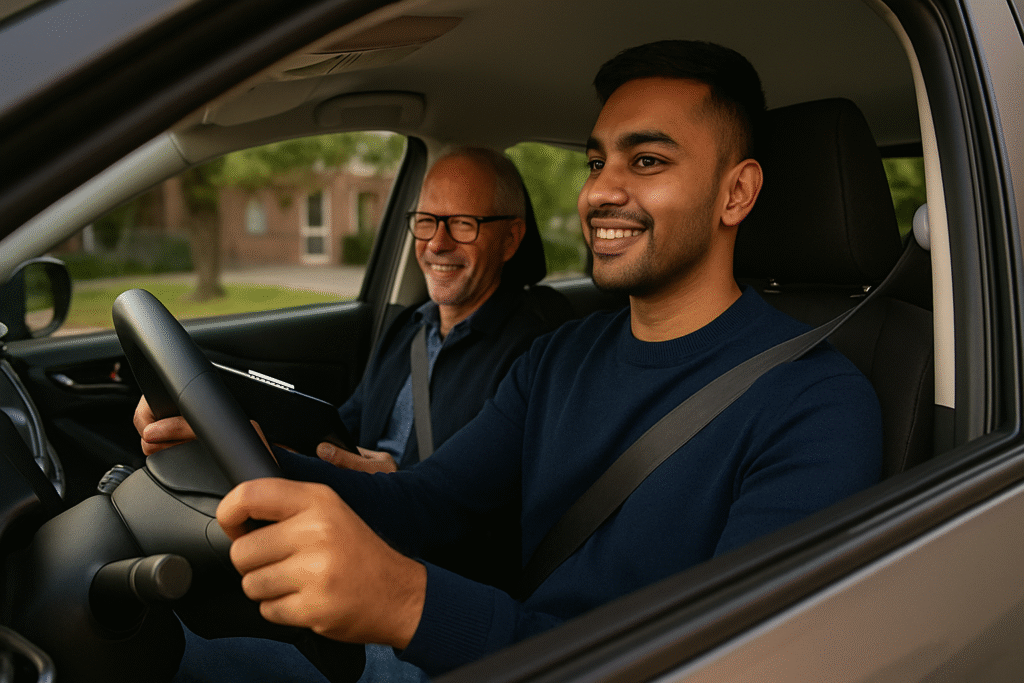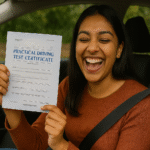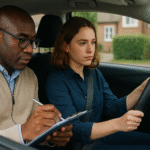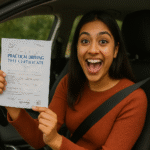The Step-by-Step Process of How to Book a Driving Test in the UK
Booking your driving test in the UK can seem daunting, but with this step-by-step guide, you’ll find it straightforward. Whether you’re a new driver or someone returning to driving after a break, understanding the process is crucial to ensure you get to that important test day without unnecessary stress.
First things first, you need to be eligible to book your driving test. Here are the key criteria:
- You must be at least 17 years old.
- You must have a provisional driving licence.
- You should have completed your driving lessons and feel prepared to take the test.
Once you’ve confirmed your eligibility, follow these steps to book your driving test:
1. Gather Required Information
Before you start the booking process, ensure you have the following handy:
- Your provisional driving licence number
- Your National Insurance number (if you have one)
- Your contact details (email and phone number)
2. Choose Your Test Type
In the UK, you can choose between two types of tests:
- Car Driving Test: For those learning to drive a standard car.
- Specialist Tests: Additional tests for vehicles such as motorcycles or large vehicles.
3. Access the Official Booking Website
To book your driving test, visit the official DVSA (Driver and Vehicle Standards Agency) website. Avoid third-party sites as they may charge extra fees.
4. Navigate to the Booking Section
On the DVSA homepage, look for the ‘Book a driving test’ option. Click on it to proceed.
5. Enter Your Details
Fill in the requested details. Make sure to input your provisional licence number and other personal information correctly to avoid any issues.
6. Choose Your Test Centre
Select a test centre near you. It’s advisable to pick a centre you’re familiar with, as this can help you feel more comfortable on the test day. You can enter your postcode or choose from a list of nearby centres.
7. Select a Date and Time
Now it’s time to choose a date and time for your test. Availability varies, so be flexible with your dates if necessary. Weekday slots often have more availability than weekends, and early morning or late afternoons may be less busy.
8. Pay the Test Fee
The fee for booking a practical driving test varies depending on the type of test you are taking:
| Type of Test | Cost |
|---|---|
| Car Driving Test | £62 (Weekdays) |
| Car Driving Test | £75 (Evenings, weekends and bank holidays) |
| Other Specialist Tests | Varies |
Payments can be made using a debit or credit card. Ensure your card details are safe and secure throughout this process.
9. Confirm Your Booking
Once you’ve completed the payment, you’ll receive a confirmation. Keep this handy; it usually includes the date, time, and booking reference for your test. Some applicants choose to print this confirmation for easy reference.
10. Prepare for Your Test
With your test booked, get ready! Spend time practicing driving in various conditions and take mock tests if possible. Consider reviewing the DVSA guidelines on what to expect during your driving test.
11. Rescheduling or Cancelling
If you need to reschedule or cancel your test, return to the DVSA website and follow the prompts for managing your booking. Remember you can change the booking details up to three days before your test date.
By following these steps, you’ll be well on your way to booking your driving test in the UK. Stay calm, prepare thoroughly, and good luck on test day!
Understanding the Different Types of Driving Tests Available
As you navigate the road to obtaining your driving license in the UK, understanding the different types of driving tests available is crucial. Each type of test serves a specific purpose and caters to various needs, allowing you to choose the right path for your driving journey.
The primary driving test most people are familiar with is the standard driving test for cars. This test is designed for learner drivers who wish to obtain a full UK driving license. However, there are several other tests tailored for specific vehicles and purposes. Knowing these can help you prepare effectively and select the test that best suits your needs.
Standard Car Driving Test
The standard driving test consists of two main components: a theory test and a practical driving test.
- Theory Test: This section assesses your understanding of road signs, rules of the road, and driving hazards through multiple-choice questions and a hazard perception test.
- Practical Test: In this test, you’ll demonstrate your driving skills in real-time. An examiner will assess your ability to operate the vehicle, follow road rules, and perform various maneuvers.
Motorcycle Driving Test
If you’re interested in riding a motorcycle, you’ll need to pass a different set of tests designed specifically for this type of vehicle. The motorcycle driving tests also consist of a theory and practical components:
- Theory Test: Similar to the car theory test, this will evaluate your knowledge about motorcycle operations and safety.
- Mod 1 and Mod 2 Tests: The practical motorcycle tests are divided into Mod 1 (off-road maneuvers) and Mod 2 (on-road riding). Mod 1 focuses on exercises like slaloms, figure eights, and emergency stops, while Mod 2 assesses your riding in traffic.
LGV and PCV Tests
If you’re looking to drive larger vehicles, such as lorries (LGVs) or buses (PCVs), the tests differ significantly. Each requires additional training and testing sessions:
- Large Goods Vehicle (LGV) Test: This test is for those looking to drive vehicles over 3.5 tons. The process includes theory tests, a hazard perception test, and two practical tests: the off-road skills test and the on-road driving test.
- Passenger Carrying Vehicle (PCV) Test: For driving buses or coaches, you must complete a theory test, practical driving test, and demonstrate your ability to safely carry passengers.
Taxi and Private Hire Vehicle Tests
For those interested in driving taxis or private hire vehicles, specific licensing and tests apply. Local councils may require prospective taxi drivers to pass a knowledge test, assessing your understanding of local routes, landmarks, and regulations.
Specialist Driving Tests
In addition to the standard tests, there are also specialist driving assessments designed for various scenarios:
- Advanced Driving Tests: Offered by organizations like the Institute of Advanced Motorists (IAM), these tests assess your driving at a higher competency level, focusing on efficiency and safety.
- Driving Instructor Tests: If you aspire to become a driving instructor, you must pass an additional set of tests to demonstrate your teaching ability and driving skills.
Booking Your Driving Test
When you’re ready to book your driving test, it’s essential to consider factors like your level of preparedness, weather conditions, and available test slots. Here are some steps to follow:
- Make sure you have a valid provisional driving license.
- Study for your theory test thoroughly.
- Book your theory test first if you haven’t already.
- Prepare for your practical driving test through lessons or practice.
- Visit the official DVSA website to find available dates for your chosen test.
- Choose a convenient location and book your test online!
Understanding the different types of driving tests available in the UK is vital for anyone looking to get behind the wheel. Each test caters to specific vehicle types and regulatory requirements, ensuring that you are adequately prepared for your driving future. With careful planning and preparation, you can confidently approach your driving test, whichever path you choose.
Tips for Preparing for Your Driving Test Success
Preparing for your driving test can be a nerve-wracking experience, but with the right approach, you can boost your confidence and improve your chances of success. Here are some practical tips to help you get ready.
Understand the Test Structure
Before diving into practice, familiarize yourself with the driving test’s structure. The test typically includes:
- Show Me, Tell Me: You’ll be asked vehicle safety questions before you start driving.
- Driving Ability: You will demonstrate your driving skills in various conditions.
- Independent Driving: You may drive for about 20 minutes without guidance, using road signs.
Take Professional Lessons
Engaging a qualified driving instructor can make a significant difference. They can provide structured lessons tailored to your needs:
- Get familiar with different driving conditions regardless of the weather.
- Receive feedback on your driving habits.
- Build a solid foundation with essential road skills.
Practice Regularly
Regular practice is crucial. Aim to drive at least a few times a week before your test. Focus on the following areas:
- Handling different types of roads, including motorways and residential areas.
- Understanding road signs and traffic rules.
- Practicing parking maneuvers, such as parallel parking and emergency stops.
Simulate Test Conditions
A helpful strategy is to simulate the test situation. Here are ways to accomplish this:
- Practice with a friend or family member acting as an examiner.
- Drive on the designated test routes to get accustomed to the area.
- Set time limits to replicate the pressure of the actual test.
Focus on the Show Me, Tell Me Questions
These questions typically cover your understanding of vehicle safety and correct usage. Here are some common examples:
| Question | Expected Answer |
|---|---|
| Show me how you’d check that the brakes are working before starting a journey. | Press the brake pedal and ensure it doesn’t feel spongy and the car doesn’t pull to one side. |
| Tell me how you’d check the power-assisted steering is working before starting a journey. | Turn the steering wheel after the engine has started to see if it moves without resistance. |
Stay Calm and Confident
On the day of your test, it’s essential to manage stress. Here are a few strategies you can adopt:
- Arrive early to give yourself time to relax.
- Take deep breaths to help calm your nerves.
- Remind yourself of your practice and skills.
Review Road Safety and Regulations
Brush up on the latest road safety regulations and driving laws. Understanding these rules is key to not only passing your test but also being a safe driver:
- Stay updated on speed limits and traffic signs.
- Know the rules for roundabouts, pedestrian crossings, and traffic lights.
Reflect on Feedback
After each practice session, take a moment to reflect on your performance. Consider these points to improve:
- Identify areas where you struggled.
- Come up with strategies to overcome specific challenges.
- Ask your instructor or practice partner for their input.
By following these tips, you can enhance your preparation for the driving test. Remember, practice makes perfect, and staying informed will help you navigate the test with confidence.
Common Mistakes to Avoid When Booking Your Driving Test
Booking your driving test is an exciting step towards achieving your driving licence in the UK. However, it’s crucial to be aware of common mistakes that could lead to unnecessary frustration or delays. Avoiding these pitfalls will help streamline your experience and increase your chances of passing on the first attempt.
One of the most prevalent mistakes is failing to check your eligibility. Before you can book a driving test, you must have a valid provisional driving licence. Ensure you have completed your theory test successfully, as you can’t book your practical driving test unless you’ve passed the theory part. Additionally, if you’re within the required time frame after passing your theory, you’re ready to move forward with scheduling your practical test.
Another common error is not fully understanding the booking process itself. The driving test can only be booked through official channels. Be cautious of third-party websites that claim to make the reservation process easier but may charge you extra fees. Stick to the official government website for the most accurate information and the safest booking experience.
Timing is everything when booking your driving test. Many learners make the mistake of waiting until the last minute. Driving tests can be booked several weeks in advance, and popular test centers may have limited availability. If you have a specific date in mind – perhaps due to a pending job requirement or personal commitment – try to book your test as soon as you feel ready. It’s better to secure your spot early rather than scramble for available slots at the last moment.
Another pitfall to avoid is not researching test centres. Each driving test centre has different pass rates and conditions. Take the time to learn about local test centres, their facilities, and any common challenges associated with them. For example, some areas might have more complex road systems that could pose a challenge during your test. Understanding the specific routes can put you in a better position to succeed.
One issue that could complicate your booking is incorrect personal information. When you fill out the booking form, ensure all your details, including name and contact information, are accurate. An error could lead to confusion or result in losing your test appointment altogether. Always double-check your information before submitting your booking.
Additionally, be aware of the cancellation and rescheduling policies. Life can be unpredictable, and sometimes you may need to change your appointment. Not knowing the cancellation rules can lead to unnecessary fees. Familiarize yourself with these policies to avoid surprises.
Preparation is key, but many learners forget to consider the test day itself. Making sure to book your test during a period when you’re confident and in good shape is essential. Don’t schedule your test for a day immediately after an exhausting week or major event. Aim for a day when you feel fresh and ready to perform at your best.
Keep in mind that many learners overlook the importance of a practical pre-test assessment. It can be tempting to jump straight into a test, but instead, consider doing a mock test with your instructor. This will give you valuable insights into your readiness and highlight any areas that may need additional focus, ensuring you’re fully prepared when the day comes.
Don’t forget about the documentation required on test day. Arrive with your provisional driving licence and any other necessary paperwork. Forgetting these items could mean you’re turned away, wasting your time and money. It’s always a good idea to prepare a checklist a few days in advance to ensure nothing is left behind.
By avoiding these common mistakes, you can make the process of booking your driving test more straightforward and efficient. Remember to check your eligibility, choose your booking time wisely, and prepare thoroughly. Ultimately, being proactive will set you up for success on the road.
What to Expect on the Day of Your Driving Test in the UK
On the day of your driving test in the UK, it’s completely normal to feel a mix of excitement and nerves. Understanding what to expect can help alleviate some of that anxiety and prepare you for a successful testing experience. Here’s a comprehensive guide to ensure you’re ready for your driving test.
Your Arrival at the Test Centre
Arriving on time is crucial. Aim to arrive at the test centre at least 10 to 15 minutes early. This allows you to gather your thoughts and check in without the stress of rushing. Make sure you bring the following items:
- Your provisional driving licence (photocard or paper licence).
- Your appointment confirmation, if applicable.
- Any necessary payment receipts.
Check-In Process
Upon arrival, you will need to check in. This typically involves a brief verification process by the staff. They may ask for your provisional licence and confirm some details about your appointment. Make sure to follow their instructions and stay calm during this step.
Meet Your Examiner
After check-in, you will meet your examiner. They are there to assess your driving skills, and it’s important to remember that they want you to succeed. You’ll start with a quick chat about the test process, and the examiner may ask you a few questions about your driving history.
Before You Start Driving
Before the driving portion begins, you’ll take part in the ‘Show Me, Tell Me’ section. Here’s what to expect:
- The examiner will ask you to show how to perform a simple safety check on your vehicle or explain a feature of the car.
- Familiarize yourself with common questions such as how to check oil levels or operate the lights. This demonstrates your understanding of vehicle maintenance.
The Driving Test
Once the preliminary checks are complete, it’s time to get on the road. You’ll drive for around 40 minutes, during which the examiner will assess your ability to operate the vehicle safely and competently. Here’s what will happen during the test:
- Expect to navigate various road types, including residential areas and busy roads.
- You may be asked to take a specific route that the examiner determines. Listen carefully to their directions.
- During the test, you will perform routine maneuvers, such as parallel parking, reversing, or making a three-point turn.
- Keep an eye out for any road signs, pedestrian crossings, and other vehicles. Your awareness is key!
Driving Test Tips
To perform at your best, consider these tips:
- Stay calm and take deep breaths if you start feeling anxious.
- Keep your speed within the limits and signal appropriately for turns and lane changes.
- Maintain a safe distance from other vehicles.
- Do a mirror check before performing any maneuvers.
After the Test
Upon returning to the test centre, the examiner will provide immediate feedback. If you pass, they will guide you through the next steps for receiving your driving certificate. If not, don’t be discouraged. You’ll receive constructive feedback to help you improve for next time. Here are a few things to keep in mind:
- It’s normal to feel upset if you don’t pass; allow yourself to process those feelings.
- Review the feedback and focus on areas that need improvement.
- Consider scheduling a few more lessons before your next attempt if required.
Equipped with this knowledge of the driving test day, you will feel more prepared and confident. Remember that every experience is a chance to improve, whether you pass on your first try or not.
Key Takeaway:
Booking your driving test in the UK can be a streamlined process when you understand the necessary steps and the various important factors involved. Here’s a key takeaway from the essential information covered in the article, broken down into the major topics discussed.
First, the process of booking a driving test starts with checking your eligibility, including holding a valid provisional license and passing the theory test. You can schedule your practical driving test through the official Driver and Vehicle Standards Agency (DVSA) website, by phone, or through approved driving instructors. Understanding the various types of driving tests—such as the standard car test, motorcycle test, and vocational tests—can help tailor your preparation according to your specific needs and vehicle category.
Preparation is crucial for success. You should practice your driving skills consistently and consider taking lessons with a qualified driving instructor who can offer valuable insights and feedback. Moreover, familiarizing yourself with the test routes and common maneuvers, including parallel parking and emergency stops, will enhance your confidence and performance during the test.
When booking your driving test, be careful to avoid common mistakes such as choosing a test date too close to your planned driving test readiness or failing to double-check your booking details. These oversights can lead to unnecessary stress or complications.
On the day of your test, be prepared for what to expect, including bringing the necessary documents such as your provisional license and theory test pass certificate. Arriving early can ease anxiety, allowing you to mentally prepare for the test.
Successfully booking your driving test in the UK involves understanding the process, preparing effectively, and avoiding common pitfalls. Each aspect, from preparation to the day of the test, works together to enhance your chances of passing and road safety. Follow these guidelines to pave the way for a successful driving test and, ultimately, a rewarding driving experience.
Conclusion
Booking your driving test in the UK can seem like a daunting task, but by following the step-by-step process outlined above, you can make the experience smoother and more manageable. Understanding the different types of driving tests available to you ensures that you select the right one for your needs and qualifications.
Preparation is key to success, so implementing the tips provided will help you feel more confident and ready when the big day arrives. Additionally, being aware of common mistakes that candidates make when booking their tests can prevent unnecessary delays and ensure that you’re well on your way to securing a test appointment that suits your schedule.
Knowing what to expect on the day of your driving test will help reduce anxiety. Familiarizing yourself with the test environment, the examiner’s role, and the various components you will be assessed on will put you in a better position to perform well.
As you embark on this journey, remember that each step is a learning opportunity, and every effort you make is an important part of becoming a skilled driver. With the right mindset and preparation, you’ll soon be on your way to passing your driving test and gaining the freedom that comes with holding a UK driving license.






Leave a Reply